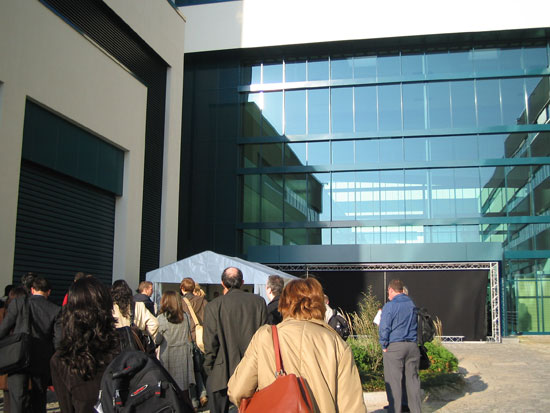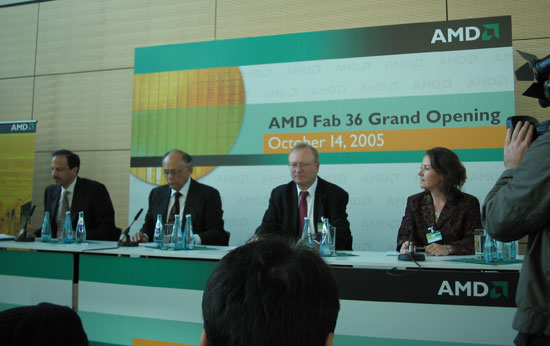AMD's Fab 36 Grand Opening - 90nm and 300mm in Germany
by Anand Lal Shimpi on October 14, 2005 7:50 AM EST- Posted in
- CPUs
After 24 months of construction, today AMD's first 300mm semiconductor fab, Fab 36, celebrates its grand opening. Built adjacent to AMD's 200mm Fab 30 in Dresden, Germany, Fab 36's grand opening takes place 6 years after Fab 30's introduction. The name Fab 36 comes from its existence 36 years after the founding of AMD.
The announcement for Fab 36's site in Dresden came in November 2003, with first ground breaking at the end of that month. Approximately 12 months later, the building was ready for equipment, and another 12 months after that, Fab 36 began preparations for mass production.

Over 150 members of the press enter AMD's press conference at Fab 36 in Dresden
Unfortunately, at its grand opening, Fab 36 is still a 90nm-only fab; throughout the next year, AMD will begin the transition to 65nm production. The first CPUs built at Fab 36 will be shipping in the first quarter of 2006, with the first 65nm chips leaving Fab 36 by the end of 2006.
Sometime in 2007 AMD will have performed a "substantial amount" of the transition of Fab 36 to a 65nm semiconductor fab, bringing the grand total for the cost of Fab 36 to an astounding 2.5 billion US dollars. There is no word when Fab 36 will be completely converted to 65nm manufacturing.
By 2008, Fab 36 will be able to produce more than 2x the number of processors as Fab 30 (potentially 100M processors per year based on current die sizes).
The first 300mm wafer produced at Fab 36 actually took place back in March, but preparation for mass production continues up to and beyond today. Today's grand opening of Fab 36 marks a huge step in AMD history, as it will hopefully alleviate a number of the supply issues they have been plagued with in recent history.

The two individuals in the middle kicked off the day at Fab 36, AMD's CEO, Dr. Hector Ruiz is the second on the left, and VP/GM of AMD Dresden, Dr. Hans Deppe is to the right of Dr. Ruiz.
The day started off with a press conference kicking off the grand opening of the fab. Below we've got a picture of a clean room engineer (or someone dressed as one) posing with AMD's Dr. Hans Deppe, the Corporate VP and General Manager of AMD in Dresden.

While we don't have a 200mm wafer here to compare sizes with, imagine the wafer pictured above, but smaller.
After some brief words about the opening of Fab 36, a brief Q&A period started. One of the first questions was what will happen to Fab 30 in the future now that Fab 36 is ready to start mass production. Dr. Ruiz mentioned that Fab 30 could be used for more x86 microprocessor production, it could potentially become a chipset manufacturing fab (possibly indicating AMD's intentions to eventually return to chipset manufacturing), or it could be upgraded to future semiconductor technologies for use in the future (e.g. 65nm).
One other important question that was asked was "why Dresden" for Fab 36, to which the answer was obviously multi-faceted:
1) First and foremost, AMD has invested a lot in the people of Dresden, when it comes to training and expertise in semiconductor manufacturing. It was simply easier to leverage the existing human investment.
2) Obviously government subsidies played a large role in AMD's decision to bring Fab 36 to Dresden. Dr. Hans Deppe listed the total amount of government subsidies for Fab 36 as 500 million US dollars.
The final question of the press conference was about AMD's future fab plans, which Dr. Ruiz answered with a timeframe of 2008 for the start of production on the next major fab plant.










70 Comments
View All Comments
Kalessian - Friday, October 14, 2005 - link
I'm sure AMD thought long and hard about making this fab 65nm right from the start. I'm not an advising panel of experts, so I don't know anyone who is. So 90nm must be better than 65nm for AMD right now. Thus, whatever is better for AMD is better for all of us.I really hope that this fab puts AMD on the map. I want to see AMD processors in my local computer stores and in Dell/HP/Gateway TV ads. I can't wait to see the outcome.
And next year we'll have 65nm K8's. Are there any plans for the next generation of AMD cores? What would 65nm bring, 3.2ghz speeds?
Questar - Friday, October 14, 2005 - link
"Thus, whatever is better for AMD is better for all of us"No. Whatever is better for AMD is better for AMD. They do not care what is better for you. They exist for one reason only, generate maximum profit for shareholders. If this happens by coincidence to benefit you, them so be it. But never think AMD is concerned about your interests at all.
Xenoterranos - Friday, October 14, 2005 - link
Really, to say AMD cares nothing about it's consumers is ludacris. AMD practivally led the overclocking movement, making it widely known how to overclock there procs. The FX line is even completely unlocked from the get-go! AMD cares more than Intel does about it's customers, if they didn't they'd be in another buisness, one where it's much easier to make money.overclockingoodness - Friday, October 14, 2005 - link
Actually, I disagree with you. The only reason AMD cares about its customers (and overclocking) is because it wants to sell more CPUs. If AMD was as big as Intel, they would have a completely different philosophy (similar to Intel). I agree with the poster who said companies only care about profits and that's true. Making you believe that a company cares for you is a clever marketing ploy that's apparently working out for them. Wait another few years and you'll see how AMD's stance changes against its customers.Why exactly would they be in a different business? AMD is known for CPUs, you can't revamp the entire company and move to a completely different sector overnight (or ever in that case).
Kalessian - Friday, October 14, 2005 - link
First off, I left out a sentence or two in my first comment. Sorry for the confusion.Blah blah none of us can say what's best for AMD because none of us are qualified for it. Then I meant to say something about how fierce competition is better for all of us. Since AMD is the smaller company, as long as it does well it's actually fighting for the stability of competition. Thus, whatever is good for AMD is good for us.
My argument is based on AMD being the smaller company. Obviously, what's good for Intel is probably bad for us (Intel owns 99% of market and it stagnates).
Anyway, in a totally nonrelated argument, I don't think it matters what the intentions of a company are. Whether it is sincerely concerned about consumers or contractually concerned about them, it doesn't make much of a difference in the short-term.
overclockingoodness - Saturday, October 15, 2005 - link
Yeah, sure AMD is fighting for the stability of competition, but for how long? As soon as AMD is anywhere close to Intel's market share (around the 50-50 mark), it'll be exactly like Intel. Look at AMD now, they aren't doing any major architectural improvements to get ready for the future because A64 is so superior. Even though Intel has been behind AMD ever since the launch of A64, it's not going to stay that way for long. Intel is starting to push the same things as AMD, but if AMD doesn't improve, Intel will take the lead (of course, that's bound to happen with every product launch).You are right, it doesn't matter, but some people don't understand that. Half of them are just supporting AMD (in the lawsuit and otherwise) because they think AMD is a "their" company (a company that supports its customers), but they are forgeting the fundamental rule of business. In business, the first and foremost thing is profits and how will those come? From customer's pockets. I think we are already seeing an example with expensive dual-core AMD CPUs compared to Intel's offerings; it's only going to get worse in the long run. Half of these people put so much faith in these companies, but ultimately, they don't care about you. And that's when they realize that every company operates exactly the same way. A company (at least as big as AMD) that supports its customers either won't be in the business for too long and is completely stupid to begin with.
You mean it doesn't matter in the long-term...
overclockingoodness - Saturday, October 15, 2005 - link
Okay, that came out wrong. What I meant to say was that whether its Intel vs. AMD or ATI vs. NVIDIA, companies will try to do each other and get the top crown with each product launch. Sometimes it'll be Intel while other times it'll be AMD.
Griswold - Friday, October 14, 2005 - link
No, its not that simple. They arent going to maximize anything but their loss if what they do is not good for the individual. So, the most important thing for a company in AMD's position is: make the customers happy or else you wont sell shit.That said, we desktop monkeys are not the be all and end all of AMD's target markets anymore. That would be servers and mobile.
trooper11 - Friday, October 14, 2005 - link
actually thats not very true.if amd didnt address at least some of our 'interests' then they wouldnt be very succesful. they have been fighting an uphill battle form the start, and one thing that has kept them aflaot is trying cater to intersts of the enthusiast market, and now the server market as they expand.
sure they want to make a profit. but you dont make a product without at least considering those intersts of your customers.
Viditor - Friday, October 14, 2005 - link
Actually, he said "Thus, whatever is better for AMD is better for all of us" which means that a successful AMD is better for us consumers...nothing said about AMD's intentions or feelings. I happen to think he's correct in that having 2 equally balanced semiconductor companies competing for our business is much better all around.
When/if AMD hits 50% marketshare, I think we all will be better off.